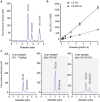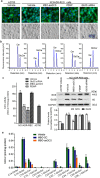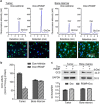Incorporation of Fluorescence Ceramide-Based HPLC Assay for Rapidly and Efficiently Assessing Glucosylceramide Synthase In Vivo
- PMID: 28592871
- PMCID: PMC5462733
- DOI: 10.1038/s41598-017-03320-9
Incorporation of Fluorescence Ceramide-Based HPLC Assay for Rapidly and Efficiently Assessing Glucosylceramide Synthase In Vivo
Abstract
Glucosylceramide synthase (GCS) is a rate-limiting enzyme catalyzing ceramide glycosylation, thereby regulating cellular ceramide levels and the synthesis of glycosphingolipids (GSLs) in cellular membranes. Alterations of GCS not only affect membrane integrity, but also closely correlate with stem cell pluripotency, cancer drug resistance, GSL storage disorders and other diseases. Enzyme activities measured conventionally with currently available ex-vivo methods do not enable reliable assessment of the roles played by GCS in vivo. We report herein a substrate-incorporation method enabling rapid and efficient assessment of GCS in-vivo activity. Upon nanoparticle-based delivery, fluorescent NBD C6-ceramide was efficiently converted to NBD C6-glucosylceramide in live cells or in mouse tissues, whereupon an HPLC assay enabled detection and quantification of NBD C6-glucosylceramide in the low-femtomolar range. The enzyme kinetics of GCS in live cells and mouse liver were well-described by the Michaelis-Menten model. GCS activities were significantly higher in drug-resistant cancer cells and in tumors overexpressing GCS, but reduced after silencing GCS expression or inhibiting this enzyme. Our studies indicate that this rapid and efficient method provides a valuable means for accurately assessing the roles played by GCS in normal vs. pathological states, including ones involving cancer drug resistance.
Conflict of interest statement
The authors declare that they have no competing interests.
Figures







Similar articles
-
Fluorescence HPLC Analysis of the in-vivo Activity of Glucosylceramide Synthase.Bio Protoc. 2019 Jun 20;9(12):e3269. doi: 10.21769/BioProtoc.3269. eCollection 2019 Jun 20. Bio Protoc. 2019. PMID: 33654788 Free PMC article.
-
Direct quantitative determination of ceramide glycosylation in vivo: a new approach to evaluate cellular enzyme activity of glucosylceramide synthase.J Lipid Res. 2010 Apr;51(4):866-74. doi: 10.1194/jlr.D002949. Epub 2009 Oct 13. J Lipid Res. 2010. PMID: 19826105 Free PMC article.
-
Ceramide glycosylation catalyzed by glucosylceramide synthase and cancer drug resistance.Adv Cancer Res. 2013;117:59-89. doi: 10.1016/B978-0-12-394274-6.00003-0. Adv Cancer Res. 2013. PMID: 23290777 Free PMC article. Review.
-
Ceramide glycosylation potentiates cellular multidrug resistance.FASEB J. 2001 Mar;15(3):719-30. doi: 10.1096/fj.00-0223com. FASEB J. 2001. PMID: 11259390
-
Therapeutic potential of targeting ceramide/glucosylceramide pathway in cancer.Cancer Chemother Pharmacol. 2013 Jan;71(1):13-20. doi: 10.1007/s00280-012-1984-x. Epub 2012 Oct 17. Cancer Chemother Pharmacol. 2013. PMID: 23073611 Review.
Cited by
-
Fluorescence HPLC Analysis of the in-vivo Activity of Glucosylceramide Synthase.Bio Protoc. 2019 Jun 20;9(12):e3269. doi: 10.21769/BioProtoc.3269. eCollection 2019 Jun 20. Bio Protoc. 2019. PMID: 33654788 Free PMC article.
-
Structure-Activity Relationship Studies of Venglustat on NTMT1 Inhibition.J Med Chem. 2023 Jan 26;66(2):1601-1615. doi: 10.1021/acs.jmedchem.2c01854. Epub 2023 Jan 12. J Med Chem. 2023. PMID: 36634151 Free PMC article.
-
Ceramide-Rubusoside Nanomicelles, a Potential Therapeutic Approach to Target Cancers Carrying p53 Missense Mutations.Mol Cancer Ther. 2020 Feb;19(2):564-574. doi: 10.1158/1535-7163.MCT-19-0366. Epub 2019 Oct 23. Mol Cancer Ther. 2020. PMID: 31645443 Free PMC article.
-
Glucosylceramide and galactosylceramide, small glycosphingolipids with significant impact on health and disease.Glycobiology. 2021 Dec 18;31(11):1416-1434. doi: 10.1093/glycob/cwab046. Glycobiology. 2021. PMID: 34080016 Free PMC article. Review.
-
Quantifying Fluorescently Labeled Ceramide Levels in Human Sarcoma Cell Lines in Response to a Sphingomyelin Synthase Inhibitor.Methods Protoc. 2019 Aug 31;2(3):76. doi: 10.3390/mps2030076. Methods Protoc. 2019. PMID: 31480447 Free PMC article.
References
-
- Basu S, Kaufman B, Roseman S. Enzymatic synthesis of ceramide-glucose and ceramide-lactose by glycosyltransferases from embryonic chicken brain. J Biol Chem. 1968;243:5802–4. - PubMed
Publication types
MeSH terms
Substances
Grants and funding
LinkOut - more resources
Full Text Sources
Other Literature Sources

